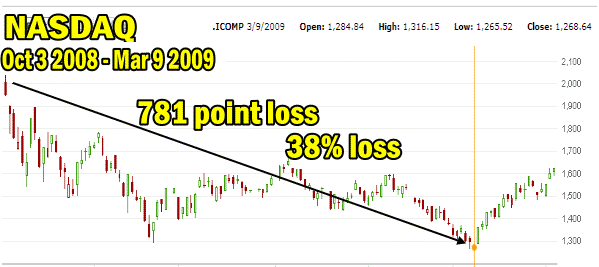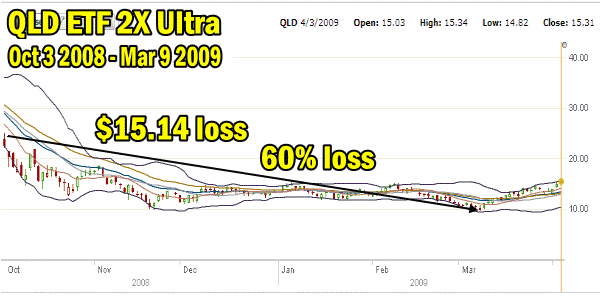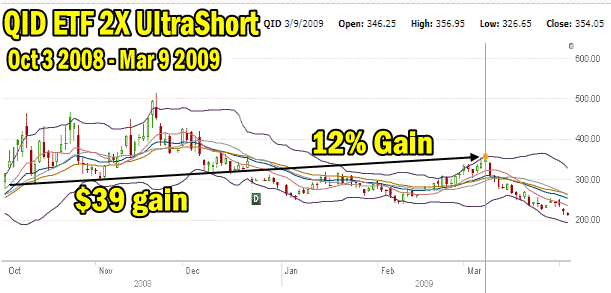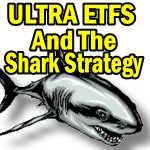The Shark Option Trading Strategy done properly can result in excellent gains while using small amounts of capital and limiting that capital’s exposure to losses. The Shark Option Trading Strategy is available through my shop in PDF format. Anyone interested can access it through this link.
On the members forum, an investor asked a few questions about the Shark Option Trading Strategy. I thought it would be better to post this article so that all investors can understand this strategy better.
Whether as an investor you are interested in trading options or not, I think you will find the information about Ultra ETFs of value in both understanding them and contemplating a use for them in a portfolio. Let’s start with the Reader’s questions.
Investor’s Questions On The Shark Options Trading Strategy
Hello,
I am very interested in purchasing Teddi’s 4 premium strategies. Not sure why I haven’t bought them already!
Anyways, the strategy that draws my attention most is the shark option strategy. Sounds like a beefed up version of the weekly wanderer which I really like.
My question is what is the typical capital commitment required per trade? Is it a strategy that can be safely done with spreads instead of naked positions? Thanks, just asking for the perspective of a smaller account size ($25k – $50k range).
Capital Required
I developed the Shark Strategy at a time when I had limited capital available. I used to trade a number of positions using the shark strategy against stocks with as small an amount as 2500.00. When my account contained just $50,000 years ago, I took $25,000 of the capital and split it into 5 Shark Strategy trades of roughly $5000.00 each. The design of the strategy is to use smaller capital amounts which assists in:
- having less capital exposed to the market at all times
- allows for quick trades in and out of a stock or Ultra ETF which means a short time frame for the trade from entry to exit
- allows for control of any trades that become unprofitable to keep losses small
- allows for building up profits quicker which then can be applied to more trades again with smaller capital needs
The last two item are perhaps among the more important.
Growing A Small Capital Base
The Shark Strategy is not built for large sums of capital. Too large a sum being used in each trade makes it more difficult to manage the trade as often some of the Ultra ETFS and indeed some stock options (think about ADM or BMY) that have poor liquidity can mean that a trade that is doing well, ends up with a mediocre returns simply because there are too many option positions to close and open. By keeping the trades smaller in scope and in capital requirements I found it easy to get into and out of a trade with both my capital and my profit intact.
As well, it is an exceptional way for an astute investor to build a small amount of capital into a larger portfolio. When I started with just $50,000 and split my capital in half, $25,000 was used in the Shark Strategy. The trades were all small and often a trade using $5000 of capital, ended up with $250 to $500 of profit. While the amount was small, I was at the outset doing just 5 trades with about $5000 dedicated to each trade. But then when the first five trades were completed, I ended up earning $2500.00. I immediately looked for an opportunity to apply that $2500 to another Shark Strategy trade.
The effect snowballs. Within a few years I found I had 20 to 30 trades ongoing at any given time and the number of trades continued to grow as did the capital. This was what I built the Shark Strategy for. It was my first attempt to get my portfolio growing quickly. Once I had earned $25,000 I took that $25,000 and moved it into Put Selling. I then worked with the original $25,000 again and set up more trades. Each time I would reach $25,000 in profits I rolled them out into more Put Selling and kept the Shark Strategy as the base for small trades, that could bring in very good returns that could grow my capital quickly. You can see how this would function. Basically, the Shark Strategy was generating income which I reused for more shark strategy trades until I had earned another $25000. Each time I earned $25,000 it was placed to work in Put Selling which meant even more income was channeled into my portfolio. It didn’t take long for the portfolio to grow.
Controlling Losses
The second most important aspect is controlling losses. The Shark Strategy does this well, again because positions are smaller and the amount of capital at risk is small. By controlling losses I quickly found that I was not spending my time trying to recover losses and then making profits. Instead, I spent very little time recovering losses, because losses when they did occur, were small and could almost always be recovered with a single trade.
Recovering losses takes months to years sometimes. The Shark Strategy was designed to keep losses under control.
Changing The Trading Field: The Ultra ETFs
Once the Ultra ETFs were launched and I experimented with them I found that returns could be better with the shark strategy than using the shark strategy with individual stocks or regular ETFs. I also found that I could invest larger sums of capital, often up to $30,000 in a single trade.
What I found out about the Shark Strategy was that it was an excellent timing system for signaling when to enter and trade and when to exit. I wasn’t looking for an automated system, but certainly a system that reduced risk of capital loss which would then mean I could put more capital to work. By having a timing system in place I found that I could better pinpoint an entry and an exit from a trade and often earn a few thousand dollars at a time. This can grow a portfolio quickly.
To help generate such large returns I turned to the Ultra ETFs like AGQ. These Ultra Type ETFs that provide 2X and 3X the return of the underlying index or asset have the leverage and volatility to provide spectacular returns with option trading. I therefore adjusted and tweaked the Shark Option Trading strategy for use on these types of Ultra ETFs.
I also developed the Shark strategy for use against Ultra ETFs to combat two problems that are common with trading Ultra ETFs.
Problems With ULTRA ETFs
1 – Leverage Creates Slippage
The biggest problem with Ultra ETFs is slippage. Investors believe that these leveraged Ultra ETFs will provide two and three times the return of the underlying indexes. Therefore many investors feel that if, for example, the S&P 500 were to gain 12% in a year, a 2 X Ultra ETF would provide a 24% return and a 3 X Ultra ETF would provide a 36% return. This is not the case due to the daily movements of the indexes themselves. Instead of ending up with a 36% gain an investor might wind up with a gain of only 10% because the longer they are in these Ultra ETFs, the more slippage there is in the price of the ETF itself due to the highly leveraged nature of these ETFs.
For example, if an index were to jump higher on a Wednesday by 5% and then collapse on a Thursday by 5%, investors in Ultra ETFs would expect an almost neutral position. This is usually not the case. Instead a sideways day or two can cause losses perhaps as high as 4%, due to the highly leverage nature of these Ultra type ETFs. Investors would do well to read the prospectus to understand Ultra ETFs before entering them. To understand better let’s take a look at how some leveraged Ultra ETFs performed in the bear market in 2008.
NASDAQ Index Decline 2008
In 2008 the NASDAQ Index fell 781 points for a 38% loss from October 3 2008 to March 9 2009.

The NASDAQ decline from October 3 2008 to March 9 2009
QLD Ultra Pro ETF 2008 Bear Market
The QLD ULTRA ETF provides a 2X return of any rise in the NASDAQ 100 Index. Therefore any person who bought this index on October 3 probably thought their loss would be 72% which is two times the loss of the underlying index. In fact losses were 60%, a full 12% less. So while the NASDAQ lost 38%, the QLD ETF did not lose 72%, but instead lost 60% of its value due to slippage over time.

QLD ETF from Oct 3 2008 to March 9 2009
QID ETF 2 X Ultra Short
The QID ETF provides a 2X Ultra Short return of the NASDAQ 100 Index. Over the same period that the NASDAQ index lost 38% and the QLD lost 60% the QID if held throughout this period only gained 12%. This is because the constant movement up and down within the NASDAQ index is constantly being reflected in the daily price of the Ultra Short ETF. You can see in the chart that there were significant periods when selling would have yielded excellent returns, but if held throughout this period the return would have been only 12%. This is the problem with highly leveraged funds.

QID ETF 2X Ultra Short From October 3 2008 to March 9 2009
2 – Timing Entry and Exit
The other problem with these highly leveraged ETFs is timing entry and exit positions. You can see from the above two Ultra ETFs that knowing when to buy and when to sell impacts the returns. There is also a lot of evidence to show that buying highly leveraged funds near a market top if you are bullish or a market bottom is you are bearish can provide shocking losses.
For example in October 2008, Warren Buffettt discussed how he was buying stocks. An investor who believed that by October 3 the collapse of stocks in the NASDAQ was already overdone, might have bought the QLD ETF to profit handsomely from what they perceived as a rebound or a bounce back of stocks. However this did not happen and instead stocks collapsed another 38%. Anyone who bought the QLD would have suffered huge losses.
Meanwhile on October 3 other investors who felt that the NASDAQ had much further to fall might have bought the QID Ultra Short. As the market did in fact collapse further, you can see in the QID chart that the best time to have sold out for large gains was in late November. Yet from late November until March 3 2009 the NASDAQ continued to plunge. The problem though was that there were also some incredible bounce backs which due to the highly leveraged nature of these ultra funds meant that the expected returns would never be realized. So an investor who held until March 3 actually only earned 12%. An investor who held beyond March 3 would have eventually lost capital. Shocking to say the least when you consider the devastation of this severe bear market.
Therefore these highly leveraged funds are not meant to be held but are meant for short-term trading.
Enter The Shark Option Trading Strategy
I tweaked the Shark Strategy to profit from these highly leveraged ETFs. It is designed for those investors who want to trade continuously within highly leveraged funds. Part of the success of the Shark Strategy is because it does not matter which way the Ultra ETF is moving. The Shark strategy pinpoints when to buy and when to sell options. Due to the highly leveraged nature of Ultra ETFs, options bought can quickly jump 50% or more in value. This is what the Shark Strategy relies upon and it works to get the investor out before the profits are lost in any bounce back whether it is a bounce lower or higher.
The whole concept of the Shark Strategy is to let the strategy pinpoint entry and exit time periods. Often a trade may last only a day or two. Therefore even if you are trading within an Ultra ETF that has only monthly options available, you may be in and out of the trade half a dozen times or more in a month. The Shark Strategy doesn’t rely on using weekly, biweekly or monthly options. It is looking at the moment to buy puts or calls and then when to sell them. Some trades can last a few weeks such as my Apple Stock trades did in 2012 as the stock was running higher and collapsed. If I had used the Shark Strategy for the Apple Stock weekly options, I would have earned considerably less because my options would have continually expired each week OR would have needed me to keep rolling the options which would have meant I would have continually be laying out more premium to buy options one week out as the stock kept rising and falling. You can understand this better if you read this article which looks at the Apple Stock trades from 2012 using the Shark Strategy. You can see that often weeks passed before a trade was closed.
Weekly Wanderer Strategy Versus The Shark Strategy
These strategies are quite different both in how they are managed and what their goal is. The weekly wanderer strategy attempts to pinpoint call and put options that have better safety levels for avoiding stock ownership when options are sold. It is designed for use against weekly options trading. The goal of the Weekly Wanderer Strategy is to earn income from selling options at strike points that have limited chances of being assigned shares.
The Shark Strategy is designed to pinpoint when to buy and when to sell options, either up or down, at any time and for any stretch of time from a few days to weeks. The Shark Strategy pinpoints when to get into a trade and when to consider leaving it. The goal of the Shark Strategy is to earn profit from the trade itself, not through selling options for premium. This is why the shark can return such large profits. It is designed to buy and sell positions.
As well as the outline above I should also mention that I designed this strategy around 5 key aspects:
1) Small amounts of capital are required for The Shark Option Trading Strategy.
2) There is no need to commit capital to share ownership at any time. Assignment and exercise are not part of the Shark Strategy.
3) Rarely am I caught at the top of a rally and rarely caught in a plunge. This is because the Shark strategy times when to get in and out. It is rare when a signal is given at a market top simply because the technical timing tools need more time period than a day or two to signal entry and exit positions. This means that when a market top is reached, it is rare for the signals to be generated because more time is needed at a market top. It is rare when a market top lasts more than a few days at best so it is odd to get a signal to enter a trade at a market top. When an Ultra ETF is plunging, signals are never flashed advising to enter a trade. A plunging market does not provide the technical signals needed to advise entry simply because a plunging market is moving too fast to generate signals. Therefore I have never been caught in a plunge when using the Shark Strategy.
4) No concern as to what direction the market is headed and no need to hold shares up or down. With owning shares in Ultra ETFS, for example as in my market direction portfolio I am constantly changing between two ETFs. One of them is an Ultra Pro such as UDOW, that rises with the rise in the index and an Ultra Short such as SDOW, that falls when the index falls. This is unnecessary with the Shark Option Trading Strategy. You simply buy and sell puts or calls depending on the market direction.
5) I find when using the Shark Strategy I rarely get caught missing a rally or a tumble in an Ultra ETF. There is no such problem as the Shark Strategy is designed to give timing signals that take two to three days to be generated. This eliminates a lot of rallies or pullbacks in stocks.
Shark Strategy Investor Questions Summary
Once I moved from trading stocks using the Shark Strategy, to trading the Ultra ETFs I used it it primarily with the AGQ ETF. Back then I indicated that I felkt the AGQ was probably the best choice. However after trading the Shark Strategy against other Ultra ETFs, I have found that any Ultra ETF that has good volume of options available and being traded, works well.
Paper Trade To Learn
I know a lot of investors do not believe in paper trading strategies to learn them. I disagree. I think paper trading have huge benefits. It can take weeks, months or years to recover losses in a portfolio. Paper trading accounts with brokerage firms are as real as actual trading. The big difference is that losses do not impact the portfolio. They can be studied and tweaked to learn a strategy inside and out. The Shark Strategy is one such strategy. It is best to learn a strategy completely and determine its suitability before risking actual capital.
For investors interested in learning the Shark Options Trading Strategy, it is part of the 4 Investment Strategies for Ultra ETFs strategy paper which can be reviewed and purchased in my store through through this link.

